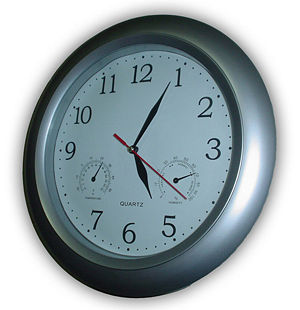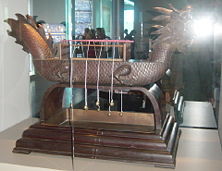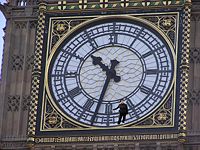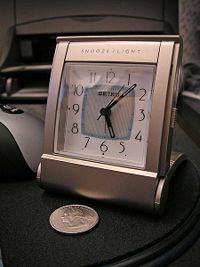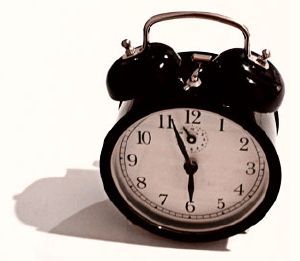Clock
- For other uses, see Clock (disambiguation).
Template:Cleanup-date
A clock (from the Latin cloca, "bell") is an instrument for measuring time. (Usually, for measuring time of intervals less than a day—as opposed to a calendar.) Those used for technical purposes, of very high accuracy, are sometimes called chronometers. A portable clock is called a watch. The clock in its most common modern form (in use since at least the 14th century)displays the hours, minutes, and sometimes seconds that pass over a twelve- or twenty-four-hour period.
History
The clock is one of the oldest human inventions. In principle, it requires no more than some physical process which will proceed at a known rate, and a way to gauge how long that process has been continuing. As the seasons and the phases of the moon can be used to measure the passage of longer periods of time, shorter processes could be used to measure off hours and minutes. The sundial, which measures the time of day by the direction of shadows cast by the sun, was widely known in ancient times. Candles and sticks of incense which burn down at approximately predictable speeds have also been used as clocks. In an hourglass fine sand pours through a tiny hole at a predictable rate.
The historian Vitruvius reported that the ancient Egyptians also used a clepsydras, a time mechanism run by flowing water. Historians disagree over the Antikythera mechanism but this is largely thought to be an early mechanical clock. By the 9th century AD a mechanical timekeeper had been developed that lacked only an escapement mechanism. There is a record that in 1176 Sens Cathedral installed a ‘horologe’—the word still used in French for large clocks. (from Greek hora, hour, and legein, to tell). This word has led scholars to believe that these tower clocks did not employ hands or dials, but “told” the time with audible signals such as bells.
A variety of mechanical clocks were produced by Spanish Muslim engineers, both large and small, and this knowledge was transmitted to Europe through Latin translations of Islamic books on mechanics. These clocks were weight-driven. Designs and illustrations of epi-cyclic and segmental gears were provided. One such clock included a mercury escapement. The latter type was directly copied by Europeans during the 15th century. In addition, during the 9th century, Ibn Firnas of Islamic Spain, according to Will Durant, invented a watch-like device which kept accurate time. The Muslims also constructed a variety of highly accurate astronomical clocks for use in their observatories.
The earliest reasonably accurate clocks are the 13th century tower clocks probably developed for (and perhaps by) monks in Northern Italy. These were used to announce the canonical hours or intervals between set times of prayer. Canonical hours differ in length, and varied as the times of sunrise and sunset shifted.
The earliest table clocks that survive in any quantity are mid-16th century ones from the metalworking towns of Nuremberg and Augsburg. These clocks have only one hand. The dial between the hour markers is divided into four equal parts making the clocks readable to the nearest 15 minutes.
The next major development in accuracy occurred in 1657 with the invention of the pendulum clock. Galileo had the idea to use a swinging bob to propel the motion of a time telling device earlier in the 17th century. Christiaan Huygens, however, is usually credited as the inventor. He determined the mathematical formula that related pendulum length to time (99.38 cm or 39.13 inches for the one second movement) and had the first pendulum driven clock made. In 1670, the English clockmaker William Clement created the anchor escapement, an improvement over Huygens' crown escapement. Within just one generation, minute hands and then second hands were added.
The excitement over the pendulum clock attracted the attention of designers resulting in a proliferation of clock forms. Notably, the longcase clock (aka grandfather clock) was created to house the pendulum and works. The English clockmaker William Clement, inventor of the anchor escapement, is credited with developing this form in 1670. It was also at this time that clock cases began to be made of wood and clock faces to employ enamel. On November 17, 1797, Eli Terry received his first patent for a clock. Terry is known as the founder of the American clock-making industry.
The development of electronics in the twentieth century led to clocks with no clockwork parts at all. Time in these cases is measured in several ways, such as by the behaviour of quartz crystals, or the decay of radioactive elements. Even mechanical clocks have since come to be largely powered by batteries, removing the need for winding.
Types
There are two major types of clocks.
Analog clocks
Analog clocks may be mechanical or have a quartz movement. A clock face is the part of an analog clock that tells time through the use of a fixed numbered dial or dials and moving hand or hands. It usually has a circular scale of 12 hours, which also serves as a scale of 60 minutes, and often also as a scale of 60 seconds. The analog clock with digital display emulates a digital clock but with an analog movement. The ultimate analog clock is the sundial, which tracks the sun continuously, registering the time by the shadow of its gnomon.
Digital clocks
Digital clocks use electronic methods of keeping time, typically the 50 or 60 hertz oscillation of AC power or a crystal oscillator as in a quartz movement. A digital clock typically displays a numerical hour range of 0-23, or 1-12 (with an indication of AM or PM) using an LCD or LED display, although digital versions of analog-style faces exist. Mains-driven digital clocks are often reset after a power failure, and, typically, begin flashing to alert us that the time they display is incorrect. After a reset digital clocks lacking a backup battery either start counting from 00:00, or stay 00:00 to indicate that their time needs to be set.
Purposes
Clocks are in homes and offices; smaller ones (watches) are carried; larger ones are in public places, e.g. a train station or church. A small clock is often shown in a corner of computer displays or mobile phones.
The main purpose of a clock is not always to display the time. It may also be used to control a device according to time, e.g. an alarm clock, a VCR, or a time bomb (see: counter).
Practically all computers depend on an accurate internal clock signal to allow synchronized processing. (A few research projects are developing CPUs based on asynchronous circuits). Some computers also maintain time and date for all manner of operations whether these be for alarms, event initiation or just to display the time of day.
Ideal clocks
An ideal clock is a scientific principle that measures the ratio of the duration of natural processes, and thus will give the time measure for use in physical theories. Therefore, to define an ideal clock in terms of any physical theory would be circular. An ideal clock is more appropriately defined in relationship to the set of all physical processes.
This leads to the following definitions:
- A clock is a recurrent periodic process and a counter.
- A good clock is one which, when used to measure other recurrent processes, finds many of them to be periodic.
- An ideal clock is a clock (i.e., recurrent process) that makes the most other recurrent processes periodic.
The recurrent, periodic process (a metronome) is an oscillator and typically generates a clock signal. Sometimes that signal alone is (confusingly) called "the clock," but sometimes "the clock" includes the counter, its indicator, and everything else supporting it.
This definition can be further improved by the consideration of successive levels of smaller and smaller error tolerances. While not all physical processes can be surveyed, the definition should be based on the set of physical processes which includes all individual physical processes which are proposed for consideration. Since atoms are so numerous and since, within current measurement tolerances, they all beat in a manner such that if one is chosen as periodic then the others are all deemed to be periodic also, it follows that atomic clocks represent ideal clocks to within present measurement tolerances and in relation to all presently known physical processes. However, they are not so designated by fiat. Rather, they are designated as the current ideal clock because they are currently the best instantiation of the definition.
Accurate navigation by ships beyond the sight of land depends on the ability to measure latitude and longitude. Latitude is fairly easy to determine through celestial navigation, but the measurement of longitude requires accurate measurement of time. This need was a major motivation for the development of accurate mechanical clocks. John Harrison created the first, highly accurate marine chronometers in the mid-18th century. The Noon gun in Cape Town still fires an accurate signal to allow ships to check their chronometers.
Modern clocks
Quartz timepieces were invented in the 1920s.
The digital clock was invented in 1956.
Specific types of clocks
- alarm clock
- analog clock with digital display
- astronomical clock
- atomic clock
- binary clock
- bracket clock
- cartel clock
- chiming clock
- clock network
- Data clock for timescapes created with time-technology
- doll's head clock
- Railroad chronometers
- countdown clock
- cuckoo clock
- flip clock
- game clock
- grandfather clock
- hourglass
- longcase clock
- mantel clock
- pedestal clock
- swinging pendulum clock
- torsion pendulum clock
- projection clock
- quartz clock
- sidereal clock
- skeleton clock
- stopwatch
- striking clock
- sundial
- tide clock
- time clock
- watch
- water clock
- world clock
See also
- chronometer
- Iron Ring Clock
- Allan variance
- biological clocks
- clock face
- Cox's timepiece
- Clock of the Long Now
- Clock signal (digital circuits)
- Clock tower
- Clockmaker
- Colgate Clock, the world's largest clock
- Horology
- Intellectual history of time
- Metrology
- National Association of Watch and Clock Collectors
- Radio clock
- Star clock
- Time standard
- Timeline of time measurement technology
- Timer
- Time to digital converter
- Watchmaker
External links
- American Watchmakers-Clockmakers Institute
- British Horological Institute
- 24 hour analog clocks
- Science Museum - more details on early clocks
- Humanclock.com a website with a unique image for every minute of the day
- [1] article, by a key figure in the development of quartz crystal clocks, on the history of timekeeping up to the late 1940s (based on remarks he made when given a prize for his contributions to horology) from The Bell System Technical Journal, Vol. XXVII, pp. 510-588, 1948
www.Timeforclocks.nl: information on Dutch clocks
ReferencesISBN links support NWE through referral fees
- Bruton, Eric. The History of Clocks and Watches. London: Black Cat, 1993.
- Edey, Winthrop. French Clocks. New York: Walker & Co., 1967.
- Lloyd, Alan H. “Mechanical Timekeepers.” In A History of Technology. Vol. III. Edited by Charles Joseph Singer, et. al. Oxford: Clarendon Press, 1957, pp. 648-675.
- Robinson, Tom. The Longcase Clock. Suffolk, England: Antique Collector’s Club, 1981.
- Smith, Alan. The International Dictionary of Clocks. London: Chancellor Press, 1996.
- Tardy. French Clocks the World Over. Part One and Two. Translated with the assistance of Alexander Ballantyne. Paris: Tardy, 1981.
- Yoder, Joella Gerstmeyer. Unrolling Time: Christiaan Huygens and the mathematization of nature. New York: Cambridge University Press, 1988.
bg:Часовник
ca:Rellotge
da:Ur (kronometer)
de:Uhr
es:Reloj
eo:Horlogxo
fr:Horloge
it:Orologio
he:שעון
nl:Klok (tijd)
ja:時計
nds:Klock (Tied)
pl:Zegar (czasomierz)
fi:Kello
sl:Ura (naprava)
sv:Klocka
th:นาฬิกา
zh:時鐘
